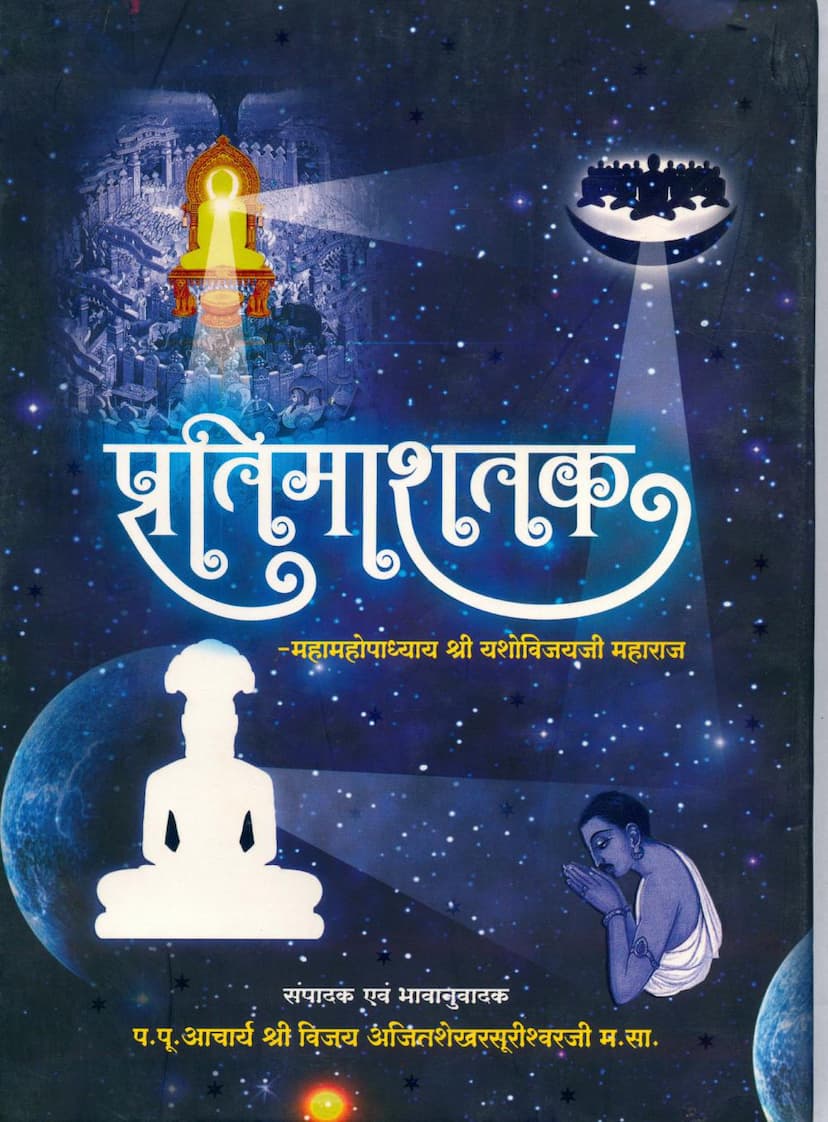Pratima Shatak
Added to library: September 2, 2025

Summary
Pratima Shatak by Ajitshekharsuri: A Comprehensive Summary
Introduction:
Pratima Shatak, authored by Mahamahopadhyay Shri Yashovijaysuri and annotated by Acharya Shri Vijay Ajitshekharsurishwarji, is a significant Jain text published by Arham Aradhak Trust. This work, consisting of 104 Sanskrit verses, delves into the profound significance of Jina pratimas (images of the Tirthankaras) as a means to realize the divine. The text aims to establish the sanctity and worshipability of these sacred images within Jainism, addressing potential doubts and refuting opposing views.
Core Theme and Argument:
The central argument of Pratima Shatak is that Jina pratimas are not mere stone idols but are the direct manifestations of the omniscient Tirthankaras, offering a tangible connection to the divine. The text emphasizes that through the proper contemplation of the Tirthankara's name, form, and essence, embodied in the pratima, one can achieve spiritual progress and ultimately attain liberation. The author, Mahamahopadhyay Yashovijaysuri, a renowned scholar of Jain logic and philosophy, meticulously uses scriptural evidence, logical reasoning, and poetic eloquence to support his thesis.
Key Concepts and Chapters (as suggested by the Table of)--:
The book systematically explores the concept of Pratima (images) through various lenses:
-
Pratima ki Pujyata (Sanctity of Images): The text asserts the inherent sanctity and worshipability of Jina pratimas, drawing upon scriptural authority and logical reasoning. It addresses the "four nishksepas" (nama, sthapana, dravya, bhava) and argues for the equivalency of sthapana (which includes pratimas) with the divine essence.
-
Refutation of Pratimalopakas (Those who oppose image worship): A significant portion of the text is dedicated to refuting the arguments of those who deny the significance of image worship. The author systematically dismantles their claims, highlighting their misinterpretations of scriptures and their reliance on flawed logic.
-
The Role of Pratimas in Spiritual Practice: The book explains how pratimas serve as aids to spiritual practice, facilitating meditation, contemplation, and the cultivation of devotion. They are seen as tangible reminders of the Tirthankaras' virtues and a means to connect with their divine presence.
-
Arguments for Idol Worship:
- Scriptural Evidence: The text cites numerous passages from Jain scriptures like the Mahanishitha Sutra, Anucharanga, Uttaradhyayana, Bhagavati Sutra, and others to support the practice of idol worship.
- Logical Reasoning (Nyaya): The author employs sophisticated logical arguments, drawing from his expertise in Nyaya philosophy, to establish the validity of image worship. He addresses concepts like the four nishksepas, the role of external aids in spiritual progress, and the difference between idol worship and blind superstition.
- Illustrative Examples (Drishtanta): The text uses compelling narratives and analogies, such as the story of Dasharatha, King Bharat and Marichi, and the conduct of divine beings, to illustrate the significance of pratimas and the devotion they inspire.
- The Importance of Intention and Bhava: While acknowledging the external form of worship, the text emphasizes the crucial role of internal devotion (bhava) in its efficacy. The purity of intention behind the worship is highlighted as the key to spiritual benefit.
-
Addressing Potential Objections: The author anticipates and systematically refutes common objections raised against image worship, such as the accusation of Himsa (violence) in fetching flowers for rituals, or the argument that pratimas are mere stone. He clarifies that these actions, when performed with proper intention and adherence to Jain principles, are not only permissible but also beneficial for spiritual growth.
-
The Example of Devas (Divine Beings): The text highlights the reverence and devotion shown by divine beings towards Jina pratimas, citing scriptural accounts where even celestial beings perform elaborate worship. This serves as a powerful testament to the sanctity and significance of these images.
-
The Role of Pratimas in the Path of Liberation: The book positions Jina pratimas not just as objects of worship but as integral components of the spiritual path, guiding devotees towards the ultimate goal of liberation (moksha). They serve as a constant reminder of the Tirthankaras' teachings and inspire the pursuit of virtues like non-violence, equanimity, and detachment.
Key Takeaways:
- Pratimas as a Means, Not the End: While emphasizing the importance of pratimas, the text subtly suggests that they are a means to realize the Tirthankaras' attributes, rather than the Tirthankaras themselves. The ultimate goal is the cultivation of inner virtues.
- The Power of Intention (Bhava): The efficacy of any ritual, including idol worship, is ultimately determined by the devotee's inner intention and devotion.
- Respect for Tradition and Logic: The author seamlessly blends scriptural tradition with rigorous logical argumentation, making the text both authoritative and intellectually stimulating.
- Relevance for All Jains: The book caters to both the scholarly and the devotional aspects of Jainism, offering insights that resonate with practitioners at various levels of spiritual understanding.
Conclusion:
Pratima Shatak is a comprehensive and insightful treatise that eloquently defends and elucidates the practice of Jina pratima worship within Jainism. It serves as a valuable resource for understanding the philosophical and practical underpinnings of this devotional practice, aiming to deepen the faith and understanding of Jains towards the sacred images that adorn their temples and guide them on their spiritual journey. The text's detailed exploration of various arguments and counter-arguments makes it a profound read for anyone seeking to understand the nuances of Jain devotional practices.